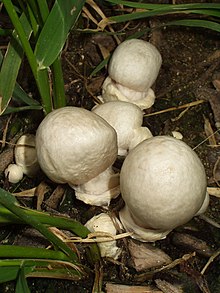
The name destroying angel applies to several similar, closely related species of deadly all-white mushrooms in the genus Amanita.[1] They are Amanita virosa in Europe and A. bisporigera and A. ocreata in eastern and western North America, respectively.[1] Another European species of Amanita referred to as the destroying angel, Amanita verna—also referred to as the "Fool's mushroom"—was first described in France in 1780.[2]
Destroying angels are among the most toxic known mushrooms; both they and the closely related death caps (A. phalloides) contain amatoxins.[1]
- ^ a b c Hallen, H. E.; Luo, H.; Scott-Craig, J. S.; Walton, J. D. (2007). "Gene family encoding the major toxins of lethal Amanita mushrooms". Proceedings of the National Academy of Sciences. 104 (48): 19097–19101. doi:10.1073/pnas.0707340104. PMC 2141914. PMID 18025465.
- ^ Bulliard JBF. (1780). Herbier de la France. Vol 1 (in French). Vol. 97–144. Paris, France: P.F. Didot. pp. 97–144, plate 108.